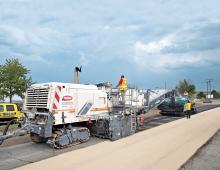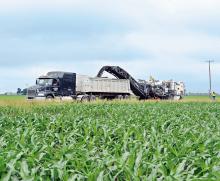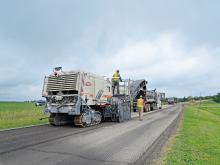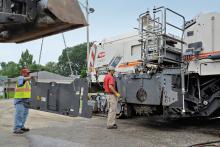Integrated construction software offers an effective planning solution - *Mark Nichols writes. In a world where resources are limited, 20 year designing and building in a sustainable way is more critical than ever. By employing today's software tools it is possible to reduce the total cost of construction of a new highway, while reducing operating costs and environmental impacts. The path to achieving the greatest gains is to take a holistic approach to the plan, design, construct and operate process from t

The use of software tools can help optimise machine operation with digital data being compatible across an array of site applications
RSS
The path to achieving the greatest gains is to take a holistic approach to the plan, design, construct and operate process from the outset of the project, and use a full range of software tools that have an integrated workflow, supporting collaboration throughout the process.
Over the last 30 years the use of software in the construction industry has grown as a set of discrete applications that create efficiencies in specific areas and solve individual problems. Today, with an ever increasing search for improved efficiency, these discrete applications are not enough. Through the combination of increased computing power, high speed graphics, the Internet, wireless communications and GPS it is now possible to integrate the workflow and provide collaboration and information tools that create a new level of efficiency.
The starting point should be the selection of a collaboration tool. When evaluating collaboration tools look for a system that has a rich field data capability and change management that can digitally reach right to the point of construction activity and back, such as machine operation. Over 90% of the cost of most projects will be for, or related to, activities that occur on-site. The system should also address the entire project from planning through design and construction to maintenance and operation.
Each project begins with the planning process, which is typically the most underfunded stage of the project, yet the point where making the right decisions can have the most profound effect on a project. Software tools, such as the2122 Trimble Quantm system, enable engineers to make better decisions from the outset. These systems simultaneously consider social, environmental, design and cost constraints and evaluate millions of alternatives in a few hours. Through a rapid iteration process engineers can complete the "what if" analysis, incorporating input from environmental to geotechnical and the public, and perform sensitivity analysis. Using software tools, the planning process can be completed much faster than with traditional methods, allowing a full evaluation of all reasonable alternatives. The net effect is faster and more thorough planning that has repeatedly been shown to identify alignments, which can save 5-15% of the project construction cost.
The integration of the planning software with traffic modelling and vehicle operation models can enable balanced decision-making that considers construction cost, environmental impact and operating cost for any highway alignment for more sustainable development.
The electronic outputs from the initial planning phase provide the base data for the next phases in the process, including providing the corridor to aerial survey planning software, to improve the efficiency of any photogrammetric or LIDAR survey, creating an initial design alignment for the detailed design process reducing design time, providing initial cost information into the project management system for financial planning and delivering project visualisation for public consultation.
The viability of any project is governed by not only the design criteria but also social and political factors. Today's software tools provide 3D simulation of the proposed new road with imagery overlays, and allow improved public communication about projects. Visualisation combined with software planning tools enable engineers to rapidly demonstrate the incorporation of public feedback, generating a new level of community engagement in the planning process and increasing public support for projects.
Time is one of the most valuable resources in any project. By considering the whole design and construct cycle, it becomes clear that intelligent use of software tools and a willingness to change work processes can create previously unthought-of efficiencies.
For example, the integration of scheduling software with visualisation software enables project managers to simulate the construction process, identifying clashes before they occur, in a fraction of the time that would be lost if the clash occurs on the job site.
The use of software tools on a project with a fixed schedule can shorten or eliminate phases, to allow more time for tasks that can also affect the costs. By shortening the planning and survey phases, more time can be invested in the detailed design to come up with more construct ion solutions that reduce the overall project duration and costs.
Fundamental to achieving efficiencies is a digital 3D model created using software from4019 Bentley Systems or 3282 AutoCAD, for example. The 3D model is developed progressively from the planning stage, through detailed design and then used for construction. More than an earthworks or paving and grading model, it should incorporate sewers, utilities, drainage, finished and subgrade, plus all structures and structural details such as bridges and tunnels. Using a software tool such as Business Center - HCE by Trimble, estimating and data preparation departments can use the 3D model to compute material quantities for a project, and to extend its use into the construction phase of the project. This 3D design model needs to be freely shared and managed using a collaboration tool that gets it to all parties as soon as the design or change is approved.
By embracing the concept of Design - Construct - Maintain - Operate, and using a single 3D model that improves and evolves throughout the entire process, a sophisticated 3D database of the completed infrastructure asset can be created. This database can be used to maintain and operate the asset after completion and the full efficiencies can be realised. This has already been demonstrated in some parts of the world, such as Australia and the Nordic regions, where technology is readily adopted and integrated through the whole construction cycle.
Significant benefits including improved rideability, improved longevity, and reduced deformation over time can also be derived through this process, decreasing wear on the pavement surface and cutting maintenance costs over time.
3D machine control has been demonstrated to reduce the staking time and costs, minimize rework, save fuel and reduce the emissions related to earthmoving, and reduce the quantity of expensive construction materials required to build the project. For example, a 2006 road construction study undertaken by178 Caterpillar compared traditional methods to 3D machine control technology. The study demonstrated fuel savings of 35%, and a 50% reduction in operating hours.
As the project progresses, current collaboration tools consolidate survey models from multiple crews and multiple machines into a single updated model, allowing for efficient project monitoring and the computation of progress volumes for payment.
It is well understood that we improve what we measure. Today's wireless and Internet infrastructure connects design engineers, project managers, field crews, operators and the machines in realtime. The fully Connected Site allows a user to automatically measure productivity, compliance and quality at new levels and provide exception reporting, eliminating the need to manually manage large amounts of data. For example, soil compaction has been tested for many years, based on sample points across a site. Today's intelligent compaction systems will measure the number of passes, the thickness of the layer and the degree of compaction for every square meter across the site, allowing the operator to see in real time that the target compaction has been achieved. The project supervisor can then extract reports on the quality and any areas of under-compaction prior to authorising the next step in the process.
Smooth running, well-coordinated operations simply work more efficiently.
Failures of any type, from late deliveries, to delays due to unscheduled machine downtime, all have a ripple effect through the project and adversely affect efficiency. The use of advanced asset management tools, such as the VisionLink system, monitor machine health, getting the critical information to your equipment manufacturer's dealer or service agent to enable preventative maintenance to occur and reducing unscheduled maintenance. Additionally, today's telematics systems also provide equipment utilisation information that enables more efficient use of expensive equipment fleets.
With the use of construction-specific collaboration tools such as Connected Community from Trimble, transfer of new and completed work orders, the latest design changes and as-built measurements or machine production data between field workers, machine operators or office managers can be performed, anywhere and anytime.
The application of software on a project spans multiple participants, from the project owner to the engineers, designers, contractors and sub-contractors. To gain the benefits of an integrated approach it is important to look for industry partners who can consult, train and support software and hardware solutions across the whole lifecycle of the project from planning through operation and maintenance.
With the potential to save time and cost at every stage, and virtually eliminate some steps in the plan design, construct and operate process, the use of an integrated software-based digital workflow can improve the efficiency and sustainability of highway construction, resulting in the earlier completion of a higher quality highway at a lower cost.
RSS
Integrated construction software offers an effective planning solution - *Mark Nichols writes
In a world where resources are limited, 20 year designing and building in a sustainable way is more critical than ever. By employing today's software tools it is possible to reduce the total cost of construction of a new highway, while reducing operating costs and environmental impacts.The path to achieving the greatest gains is to take a holistic approach to the plan, design, construct and operate process from the outset of the project, and use a full range of software tools that have an integrated workflow, supporting collaboration throughout the process.
Over the last 30 years the use of software in the construction industry has grown as a set of discrete applications that create efficiencies in specific areas and solve individual problems. Today, with an ever increasing search for improved efficiency, these discrete applications are not enough. Through the combination of increased computing power, high speed graphics, the Internet, wireless communications and GPS it is now possible to integrate the workflow and provide collaboration and information tools that create a new level of efficiency.
The starting point should be the selection of a collaboration tool. When evaluating collaboration tools look for a system that has a rich field data capability and change management that can digitally reach right to the point of construction activity and back, such as machine operation. Over 90% of the cost of most projects will be for, or related to, activities that occur on-site. The system should also address the entire project from planning through design and construction to maintenance and operation.
Each project begins with the planning process, which is typically the most underfunded stage of the project, yet the point where making the right decisions can have the most profound effect on a project. Software tools, such as the
The integration of the planning software with traffic modelling and vehicle operation models can enable balanced decision-making that considers construction cost, environmental impact and operating cost for any highway alignment for more sustainable development.
The electronic outputs from the initial planning phase provide the base data for the next phases in the process, including providing the corridor to aerial survey planning software, to improve the efficiency of any photogrammetric or LIDAR survey, creating an initial design alignment for the detailed design process reducing design time, providing initial cost information into the project management system for financial planning and delivering project visualisation for public consultation.
The viability of any project is governed by not only the design criteria but also social and political factors. Today's software tools provide 3D simulation of the proposed new road with imagery overlays, and allow improved public communication about projects. Visualisation combined with software planning tools enable engineers to rapidly demonstrate the incorporation of public feedback, generating a new level of community engagement in the planning process and increasing public support for projects.
Time is one of the most valuable resources in any project. By considering the whole design and construct cycle, it becomes clear that intelligent use of software tools and a willingness to change work processes can create previously unthought-of efficiencies.
For example, the integration of scheduling software with visualisation software enables project managers to simulate the construction process, identifying clashes before they occur, in a fraction of the time that would be lost if the clash occurs on the job site.
The use of software tools on a project with a fixed schedule can shorten or eliminate phases, to allow more time for tasks that can also affect the costs. By shortening the planning and survey phases, more time can be invested in the detailed design to come up with more construct ion solutions that reduce the overall project duration and costs.
Fundamental to achieving efficiencies is a digital 3D model created using software from
By embracing the concept of Design - Construct - Maintain - Operate, and using a single 3D model that improves and evolves throughout the entire process, a sophisticated 3D database of the completed infrastructure asset can be created. This database can be used to maintain and operate the asset after completion and the full efficiencies can be realised. This has already been demonstrated in some parts of the world, such as Australia and the Nordic regions, where technology is readily adopted and integrated through the whole construction cycle.
Significant benefits including improved rideability, improved longevity, and reduced deformation over time can also be derived through this process, decreasing wear on the pavement surface and cutting maintenance costs over time.
3D machine control has been demonstrated to reduce the staking time and costs, minimize rework, save fuel and reduce the emissions related to earthmoving, and reduce the quantity of expensive construction materials required to build the project. For example, a 2006 road construction study undertaken by
As the project progresses, current collaboration tools consolidate survey models from multiple crews and multiple machines into a single updated model, allowing for efficient project monitoring and the computation of progress volumes for payment.
It is well understood that we improve what we measure. Today's wireless and Internet infrastructure connects design engineers, project managers, field crews, operators and the machines in realtime. The fully Connected Site allows a user to automatically measure productivity, compliance and quality at new levels and provide exception reporting, eliminating the need to manually manage large amounts of data. For example, soil compaction has been tested for many years, based on sample points across a site. Today's intelligent compaction systems will measure the number of passes, the thickness of the layer and the degree of compaction for every square meter across the site, allowing the operator to see in real time that the target compaction has been achieved. The project supervisor can then extract reports on the quality and any areas of under-compaction prior to authorising the next step in the process.
Smooth running, well-coordinated operations simply work more efficiently.
Failures of any type, from late deliveries, to delays due to unscheduled machine downtime, all have a ripple effect through the project and adversely affect efficiency. The use of advanced asset management tools, such as the VisionLink system, monitor machine health, getting the critical information to your equipment manufacturer's dealer or service agent to enable preventative maintenance to occur and reducing unscheduled maintenance. Additionally, today's telematics systems also provide equipment utilisation information that enables more efficient use of expensive equipment fleets.
With the use of construction-specific collaboration tools such as Connected Community from Trimble, transfer of new and completed work orders, the latest design changes and as-built measurements or machine production data between field workers, machine operators or office managers can be performed, anywhere and anytime.
The application of software on a project spans multiple participants, from the project owner to the engineers, designers, contractors and sub-contractors. To gain the benefits of an integrated approach it is important to look for industry partners who can consult, train and support software and hardware solutions across the whole lifecycle of the project from planning through operation and maintenance.
With the potential to save time and cost at every stage, and virtually eliminate some steps in the plan design, construct and operate process, the use of an integrated software-based digital workflow can improve the efficiency and sustainability of highway construction, resulting in the earlier completion of a higher quality highway at a lower cost.
| Author *Mark Nichols, general manager, Trimble Planning Solutions |
RSS











